Get to Know You Favorite Snack
Bird-Friendly Communities
Become to Know These 20 Common Types of Native Plants
Whether you're looking to increase your awareness outdoors or attract more than birds to your home, let this primer be your guide.
Plants are admittedly crucial to avian life. Copse, flowers, shrubs, and grasses can serve as shelter, nesting material, and veritable buffets for birds. But non all plants are equal depending where you live: Research has shown that native plants that have evolved within sure ecosystems exercise a much better job of supporting bird species than not-native ones. Knowing which plants are native and which are not, however, isn't always easy. This primer should help.
Having a basic level of native plant literacy is beneficial for a variety of reasons. When out in the wild, it can brand yous a better birder, since these are the plants that birds are more probable to collaborate with in their natural habitats. Plus, knowing what plants are all-time suited to your region will assist make your g, balcony, or patio more bird friendly. With a little work and planning, y'all could be rewarded with an irised Blood-red-throated Hummingbird drinking from tubular columbine, or a group of Cedar Waxwings nibbling on serviceberries.
Understanding the of import part native plants play volition also brand yousameliorate equipped to be a vocalisation for your community, says Marlene Pantin, partnerships manager for Audubon's Plants for Birds program. "If we desire to be having conversations with urban center officials, we have to come with plants in mind that are best for them to use on city streets," she says.
The groups listed here are some of the most common native plant genera in the country. In the Lower 48 states in particular, y'all're likely to find species under many of these umbrellas that are native to your region. Just non-native species in virtually of these groups might also exist available—that's why it'due south of import to know what'due south recommended for your locality. In one case you find your favorites from this listing, just check out Audubon's native plants database to find which species are recommended for your cipher code.
Copse
Oaks (Quercus spp.)
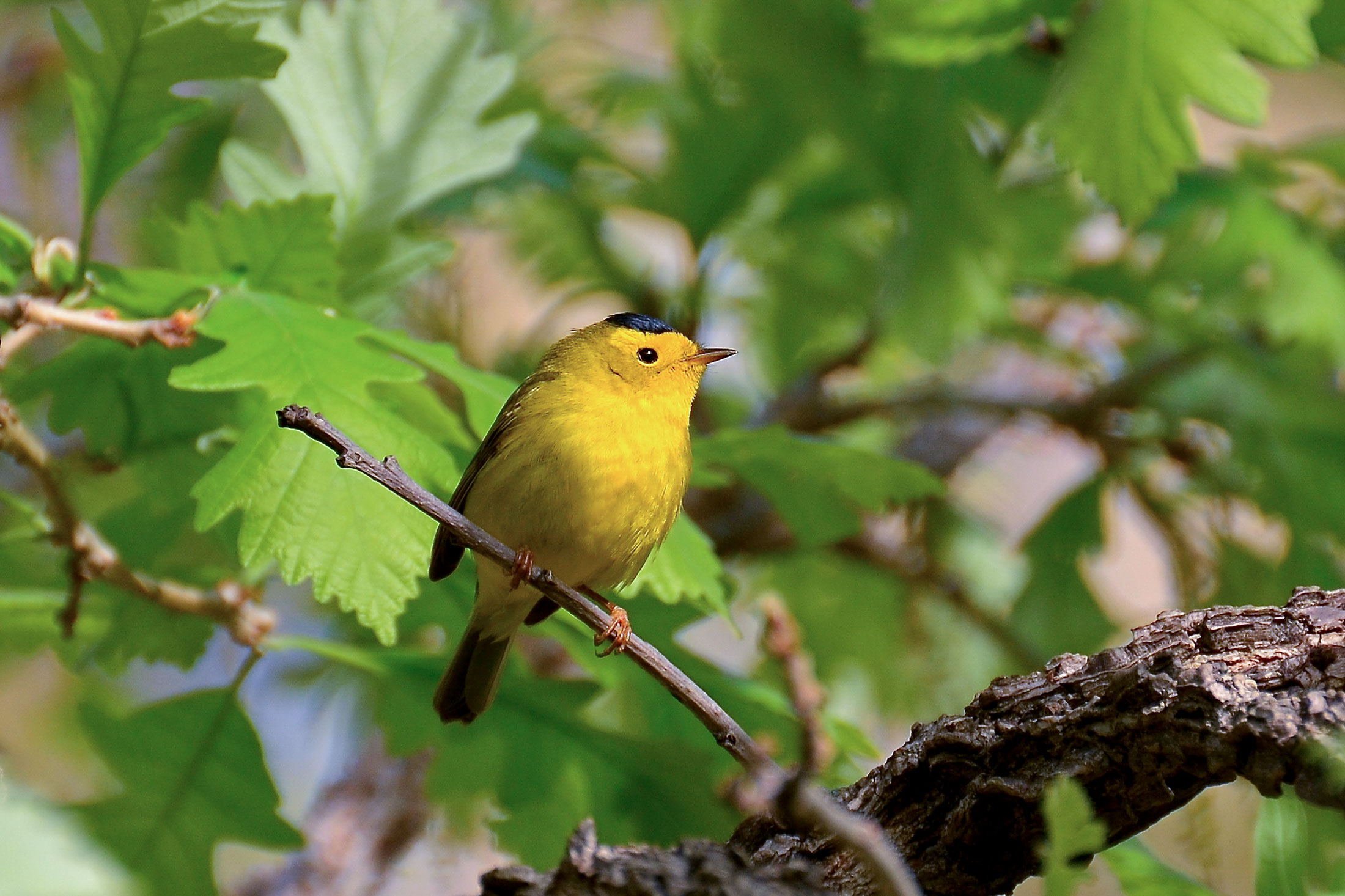
Identifiable by their securely ridged bark and lobed leaves, oak copse bring colorful autumn foliage to your yard, street, or nearby park. Acme differs past species, but many of these often slow-growing trees can reach xl to 80 anxiety tall. They're a hub for biodiversity, supporting countless birds and insects—including caterpillars of 557 species of collywobbles and moths.
Plant Notes: In that location are up of 200 oak species native to the Usa, according to the Biota of North America Program. Find your local native species on the Audubon native plants database.
Bird Notes: All sorts of songbirds will eat insects that live in oak trees, while woodpeckers, jays, and others will consume the acorns. Oak copse also make great homes for birds that nest in cavities, such as woodpeckers, bluebirds, Barn Owls, and Woods Ducks.
Pines (Pinus spp.)

While most people are familiar with pine trees, they might not be aware that there are nearly 120 species of this conifer worldwide. These evergreen trees have pointed needle leaves that help store water and provide year-long awning cover that shelters animals. Yous can distinguish a pine from other cone-producing trees past its clusters of needles in groups of two, three, or five. Pines support 203 butterfly and moth species, and their seeds tucked away in cones are a favorite snack for birds.
Plant Notes: In the Eastward and Upper Midwest, select an eastern white pine (P. strobus), which hosts virtually 50 species of birds. In the West, effort a Ponderosa pine (P. ponderosa), western white pino (P. monticola), or sugar pino (P. lambertiana). Bristlecone pines (P. aristata and P. longaeva) are native to the Southern Rocky Mountain expanse, and in the South, try a longleaf (P. palustris) or loblolly (P. taeda) pine. Avert non-native pine species such as the Scotch Pino (P. sylvestris) and Australian Pine (P. nigra).
Bird Notes: Finches, nuthatches, grosbeaks, and chickadees volition eat pine "nuts"—the seeds from the pinecones—and birds can detect shelter under the leafy limbs. Pine needles are good fabric for making nests.
Dogwoods (Cornus spp.)
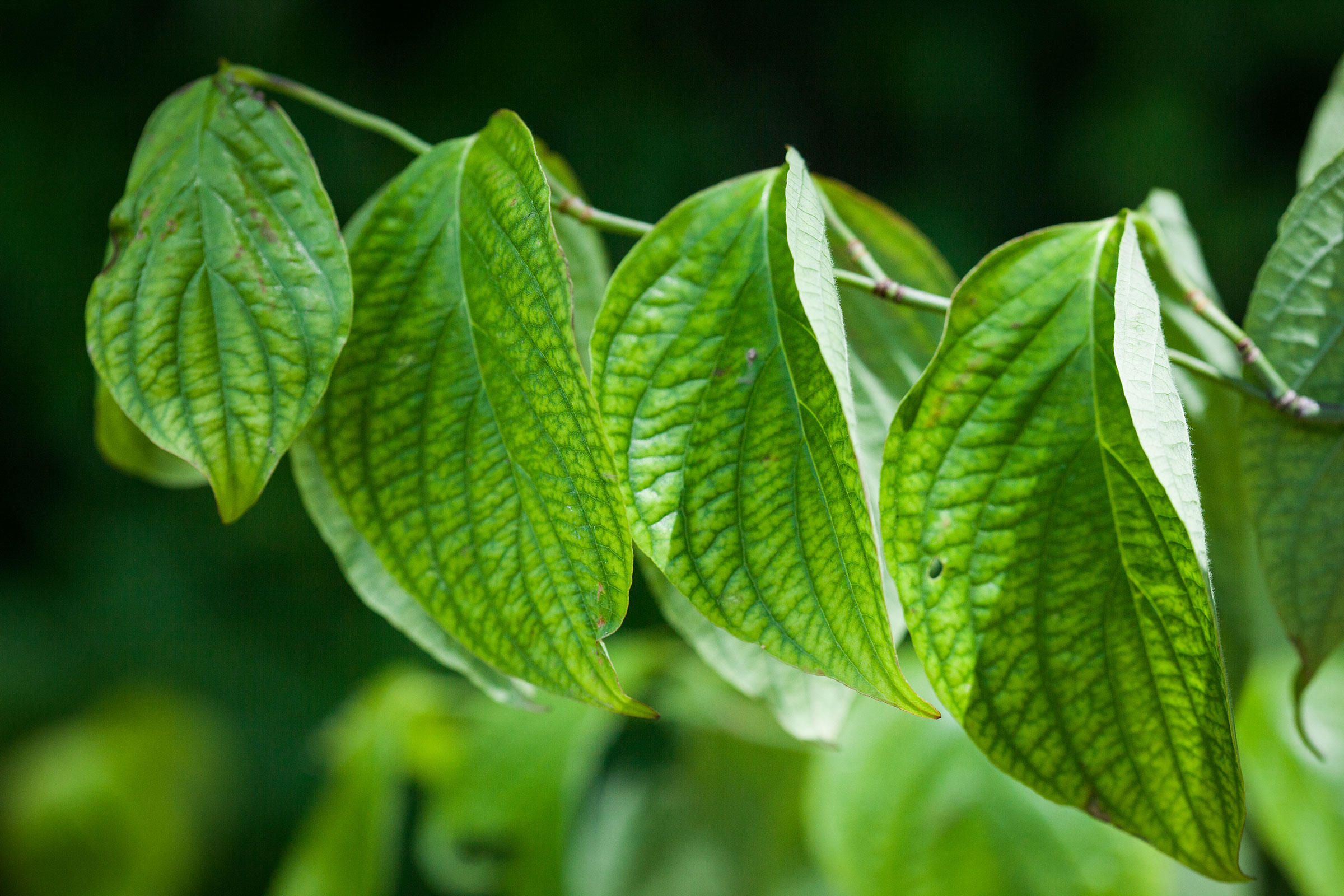
The characteristic white or pinkish blossoms of a dogwood tree are actually not petals merely leaves (called bracts) surrounding small dark-green flowers. Nevertheless, they're a beautiful springtime sight. Throughout the year, a dogwood's brandish continues as its oval-shaped leaves turn red in the fall and red fruit appears from fall into wintertime, though some species produce white or blue-blackness fruit. Come winter, dogwood trees' scaly bark, often compared to alligator peel, stands out among bare branches. Dogwoods benefit the ecosystem by pulling calcium from the ground up into their leaves and enriching the soil when they autumn.
Institute Notes: At that place are virtually a dozen species of dogwoods native in the U.s.. In the East and Midwest, try the flowering dogwood (C. florida). Westerners, look for the Pacific dogwood (C. nuttallii), which produces a bonus outburst of colour in the autumn, when it may blossom a 2d time.
Bird Notes: More than 35 species of birds will swallow the berry-like fruit (called a drupe) produced by dogwood trees. These include Northern Cardinals, Tufted Titmice, Dark-eyed Juncos, Gray Catbirds, bluebirds, and waxwings.
Willows (Salix spp.)

Willows are quite flood-tolerant and prefer to grow in slightly moisture soil. Many species have petal-less, long flowers called catkins, and each flower is male person or female—some species, such as the pussy willow, have entire trees that are male or female person.
Constitute Notes:Arguably the about famous willow, the Weeping Willow is actually a non-native species. But never fearfulness, information technology has lovely native alternatives such equally the fast-growing black willow (S. nigra), native in the Eastern and Central U.S., and the pussy willow (S. discolor), which grows in the northern and eastern parts of the land. If you lot identify a willow branch in water, it can sprout roots and get transplanted outside.
Bird Notes:Migratory birds like kinglets and warblers can feed on insects that willow blossoms attract, and insectivorous birds, woodpeckers, and the Yellow-bellied Sapsucker are also attracted to black willow trees. Hummingbirds and others make nests using the fluff from pussy willow catkins.
Flowers
Milkweeds (Asclepias spp.)
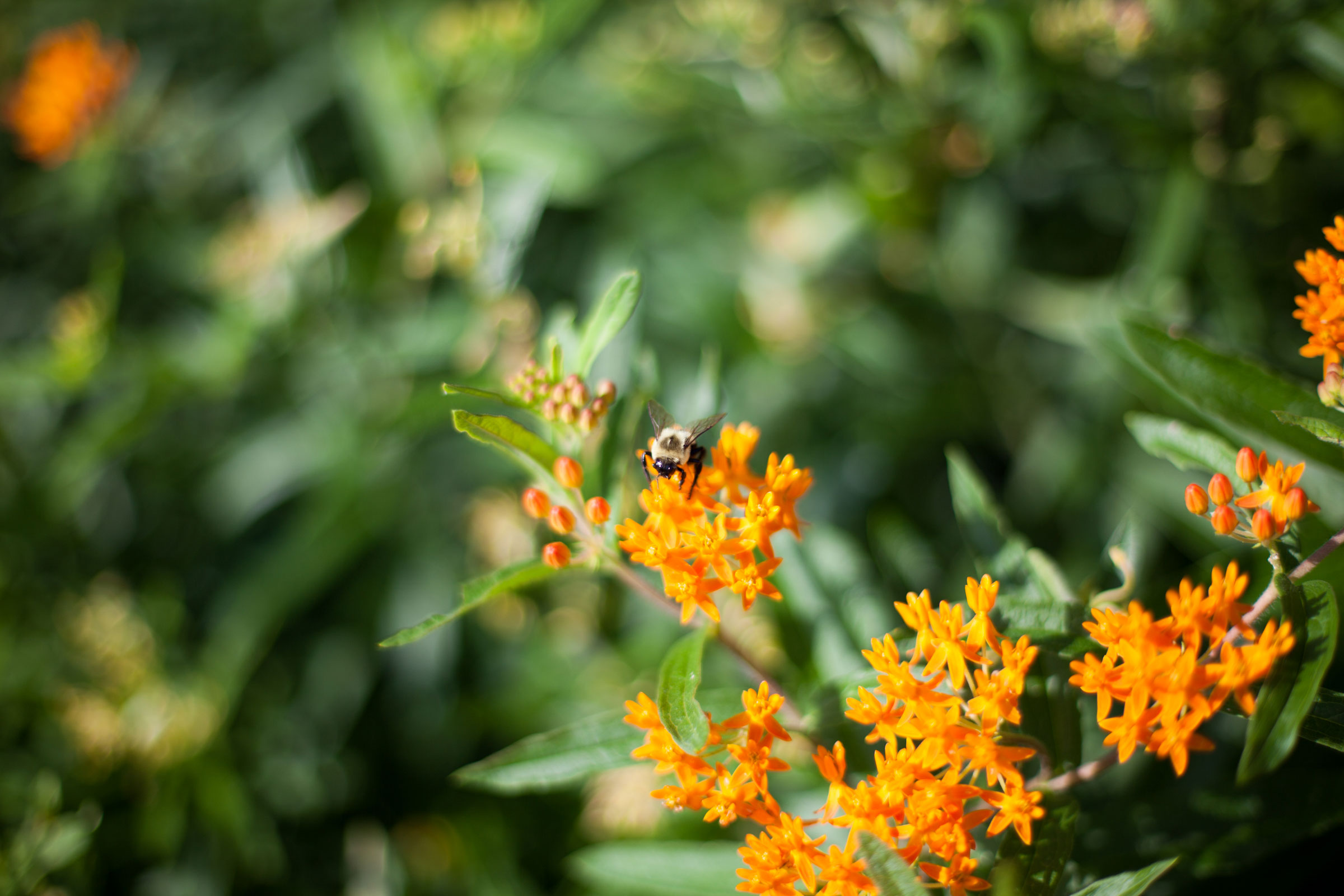
Milkweeds grow ball-shaped clusters of flowers that can be majestic, pinkish, cerise, white, green, yellow, or orange. In late summer, narrow dark-green seed pods adorn these plants. Milkweed famously attracts monarch collywobbles and provides food for their caterpillars. As monarch caterpillars consume milkweed, they develop a toxicity that makes them undesirable to predators as an adult. Just milkweeds are also useful for birds, particularly as nesting materials.
Plant Notes: You desire to avoid tropical milkweed—this is not-native, and it doesn't dice back in the wintertime, like most milkweed. This means two things: Monarchs might exist tempted to stay on this constitute in winter rather than migrate, and a milkweed-home parasite that kills monarchs tin can also stick effectually all year long. Instead, depending on your region, cull a native diverseness such equally mutual, swamp, purple, white, or whorled milkweed, or butterfly weed, which is the most drought-tolerant milkweed.
Bird Notes: Some birds, like orioles and finches, use fibers from fluffy milkweed seeds to line their nests. Hummingbirds like to feed on milkweed. And insect-eating birds such equally Indigo Buntings may be attracted to the caterpillars that milkweed supports.
Coneflowers (Echinacea spp.)

Coneflowers take a raised center with petals forming a flat ring around it. This genus, called Echinacea, is named for the Latin echino, meaning spiny, equally its center looks rather pointy. The blossoms tiptop leafy stems that stretch two to 4 feet tall in sunny areas with well-drained soil. Pollinators, especially bees, love these flowers.
Plant Notes: Await for the pale imperial coneflower (E. pallida) in the Cardinal U.S., and the purple coneflower (E. purpurea) in the Southeast. Check the native plants database for other local species.
Bird Notes: Insectivorous birds are drawn to these pollinator magnets while they're in bloom in summer and early autumn, and hummingbirds will sip coneflower nectar. Goldfinches, Blue Jays, Northern Cardinals, and other species similar to consume coneflower seeds in the autumn and winter.
Coneflowers (Rudbeckia spp.)

Rudbeckia is another genus of coneflower, which is native to prairies and damp woodlands. One common Rudbeckia coneflower species is the Blackness-eyed Susan (R. hirta), identifiable by its yellowish-orange halo of petals around a dark center.
Establish Notes: Black-eyed Susans are common in native plant gardens, every bit they tin can attract 17 kinds of collywobbles and moths. With a couple dozen Rudbeckia species native to the U.S., exist sure to employ the native plants database to discover your local variety.
Bird Notes: A wide range of species like to eat the seeds of Rudbeckia flowers, including Northern Cardinals, goldfinches, chickadees, nuthatches, and sparrows.
Sunflowers (Helianthus spp.)

These golden blossoms are known for their meridian—many abound taller than the average person. Only with dozens of species native to North America, there's plenty of diverseness: The little sunflower ( H. pumilus), for example, averages just ane to 3 feet tall. Each sunflower is actually fabricated upwardly of scores to thousands of smaller blossoms—in fact, a sunflower's center consists of many tiny blooms, and each petal is likewise classified equally a flower of its ain. It's no wonder pollinators love these plants.
Institute Notes: Bank check to find out which species are best for your area. Some species, such as the common sunflower (H. annuus), are native in some parts of the country but invasive in others.
Bird Notes : A wide variety of species similar to eat sunflower seeds, including Northern Cardinals, goldfinches, siskins, grosbeaks, jays, finches, and many others.
Sages (Salvia spp.)

Perchance you lot've used sage in recipes to add its earthy flavor or nutritious benefits, like antioxidants and the healing Vitamin K. Or perchance you lot've burned dried sage leaves, which can purify the air, remove bacteria, and repel insects. Pollinators like to use sage, likewise—these fast-growing and drought-tolerant flowering plants concenter hummingbirds, bees, and butterflies.
Institute Notes: In the Central and Southeastern U.S., try pitcher sage (S. azurea). Many sage species are native to the Western U.S., especially in Texas. Employ the Audubon native plant search tool to detect what species are best at your location.
Bird Notes: When a hummingbird sticks its beak into a sage flower, it pushes a kind of "lever" that releases the pollen-containing stamen, which is unremarkably hidden in a sage's petals. The pollen and then rubs onto the hummingbird'south head and travels to the next blossom.
Blazing star (Liatris spp.)

This plant grows 2-5 feet tall and can be recognized by its flowers on a stalk, which flower from the top downwards. It has an hugger-mugger stem called a corm, which looks like a bulb and stores water to assist the plant through dry times. Blazing star grows all-time in total dominicus with poor, rocky soil and dry out conditions.
Plant Notes: In the eastern U.S., await for rough blazing star (Fifty. aspera) or gayfeather (L. spicata). In the West, choose Rocky Mount blazing star (L. ligustylis). For residents of the central U.Southward., try prairie blazing star (L. pycnostachya).
Bird Notes: The seeds of blazing star may attract American Goldfinches, Blackness-capped Chickadees, Indigo Buntings, or Tufted Titmice, and insectivorous birds may consume the butterflies and other insects that like this constitute.
Columbines (Aquilegia spp.)

The columbine flower is named afterward non one, but 2 birds—columbine comes from the Latin word columba, or pigeon-like, and its scientific name, genus Aquilegia, is related to the Latin word for eagle: aquilae. Supposedly, the upside-downwardly flower looks similar a cluster of doves, and its petals stretch backward into tubes called spurs, which resemble an hawkeye's talons. But that doesn't scare abroad the pollinators that frequent this slight shade- and lord's day-loving institute.
Plant Notes: Easterners, choose the eastern red columbine (A. canadensis). In the West, find your local variety of bluish, yellow, or cherry columbine.
Bird Notes: In spring and summer, shimmering hummingbirds potable nectar from narrow columbine flowers.
Goldenrods (Solidago spp.)
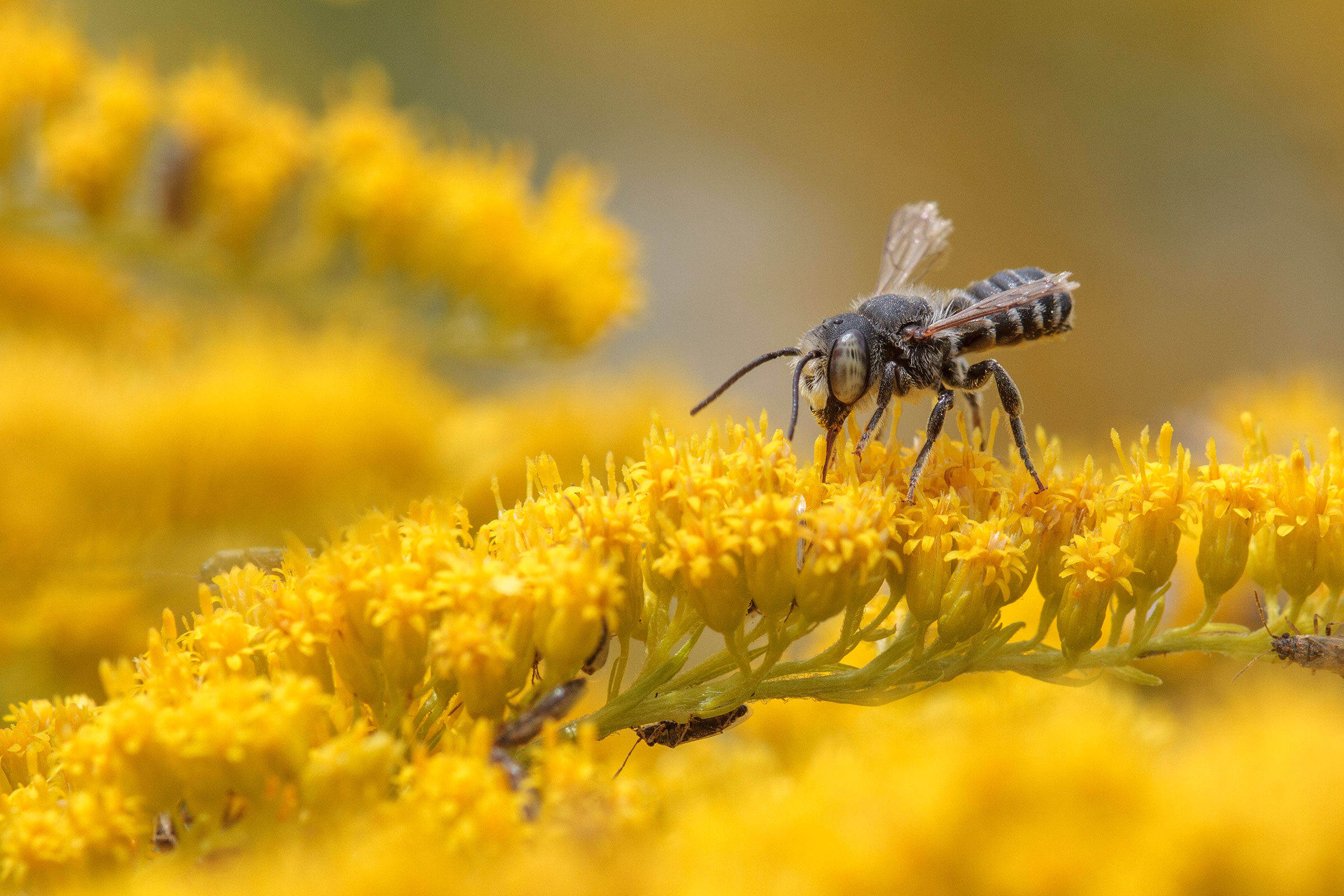
Goldenrods are magnets for pollinators; they support 115 different butterfly and moth species, according to native plants researcher Doug Tallamy. True to its name, this plant has stalks of yellow flowers. Goldenrods flower from the stop of summertime into the fall, which makes them a good plant for a butterfly garden and to complement the summertime-blooming milkweed.
Plant Notes: Most goldenrod species are native to North America, and many are native to the eastern U.Southward. Observe what'southward best for your surface area with the native plants database.
Bird Notes: Woodpeckers and chickadees might swallow fly larvae that alive on goldenrods, and other insectivorous birds may be fatigued to the collywobbles. Enough of birds also eat goldenrod seeds, particularly the American Goldfinch.
Asters (Symphyotrichum spp.)

Asters attract up to 112 species of butterflies and moths, making them, like goldenrods, a worthy addition to a fall-blooming butterfly garden. Their narrow petals can be royal, pinkish, blue, or white. Aster species vary in height, but many grow between 1 and iii feet tall. They're also versatile—some species are sunday-loving and others thrive in shade.
Plant Notes: In the central and eastern U.S., endeavour the aromatic aster (S. oblongifolius) or New England aster (S. novae-angliae). Out Westward, look for the western aster (S. ascendens) or the rayless aster (S. ciliatum).
Bird Notes: Asters might attract insect- and seed-eating birds, especially during fall migration, when they bloom. Await out for goldfinches and chickadees around these plants.
Beardtongue (Penstemon spp.)
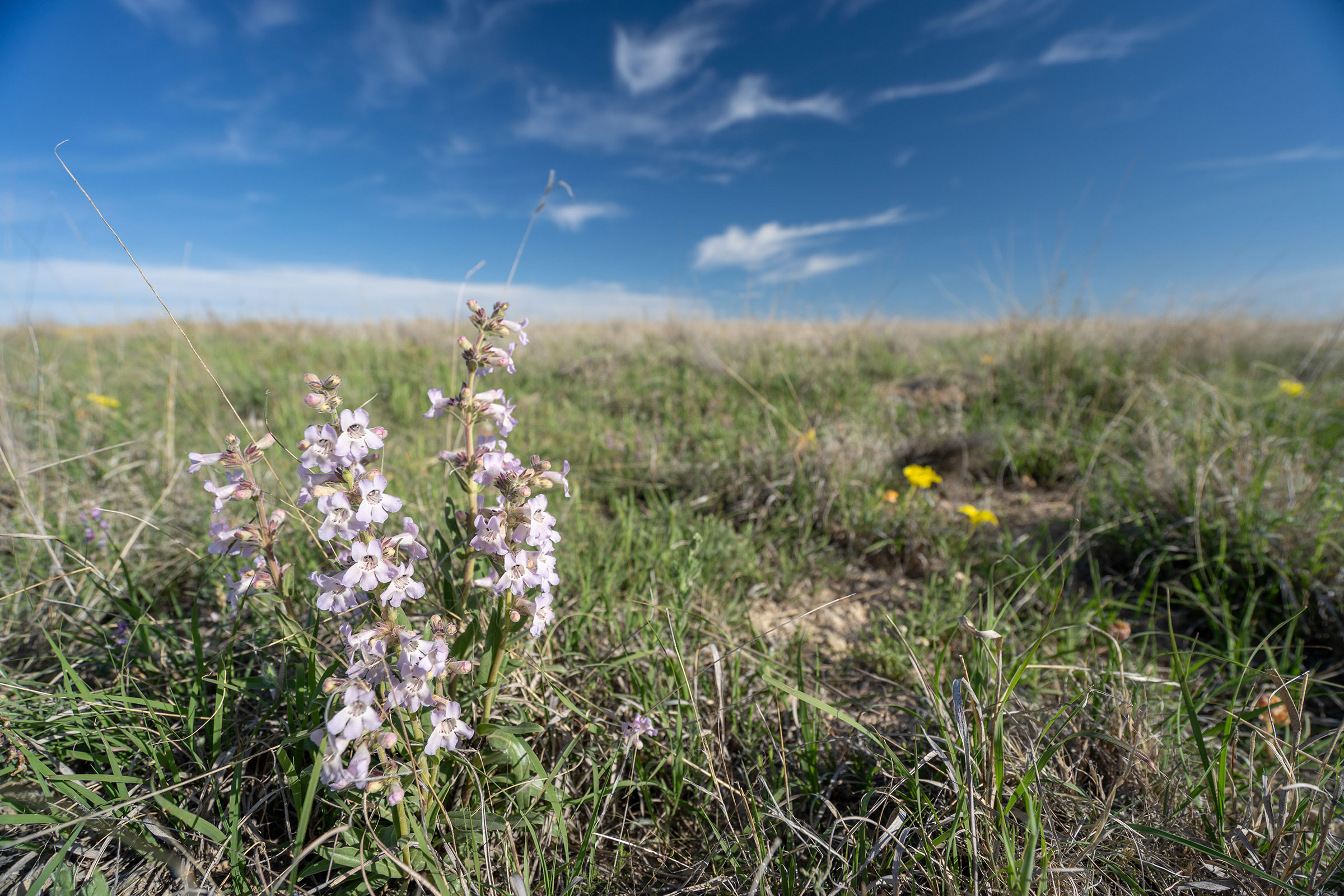
There's great diverseness among penstemon species—some are only inches tall, while others stretch feet into the air. Their tubular flowers may be white, yellow, blue, regal, or cherry-red. These tin can be adequately hardy plants, as they appreciate well-tuckered soil while likewise existence able to withstand dry conditions. Penstemons might be relatively short-lived (three to four years), simply they propagate hands and attract butterflies and bees.
Plant Notes: There are about 250 species of penstemons that are native to North America, with many growing in the western United States. Due to the variety of penstemons, check to see which kinds are native to your region using the Audubon native plants database.
Bird Notes: Hummingbirds love to drink nectar from these flowers, and basis-feeding songbirds such as sparrows swallow penstemon seeds.
Berries
Serviceberries (Amelanchier spp.)

These trees make white flowers in the spring and host bright-colored leaves come up autumn. Serviceberry leaves back up hungry caterpillars, and the flowers concenter adult butterflies. The berries themselves are very attractive to birds, but they also taste not bad to humans—like a blueberry, just sweeter!
Plant Notes: There are many varieties of serviceberry that are native across much of the country. Use the Audubon native plants database to find out what is all-time for your region.
Bird Notes: Northern Cardinals, Cedar Waxwings, tanagers, grosbeaks, vireos, robins, and other birds are attracted to the fruit of serviceberries. These trees also provide a good nesting spot.
Elderberries (Sambucus spp.)
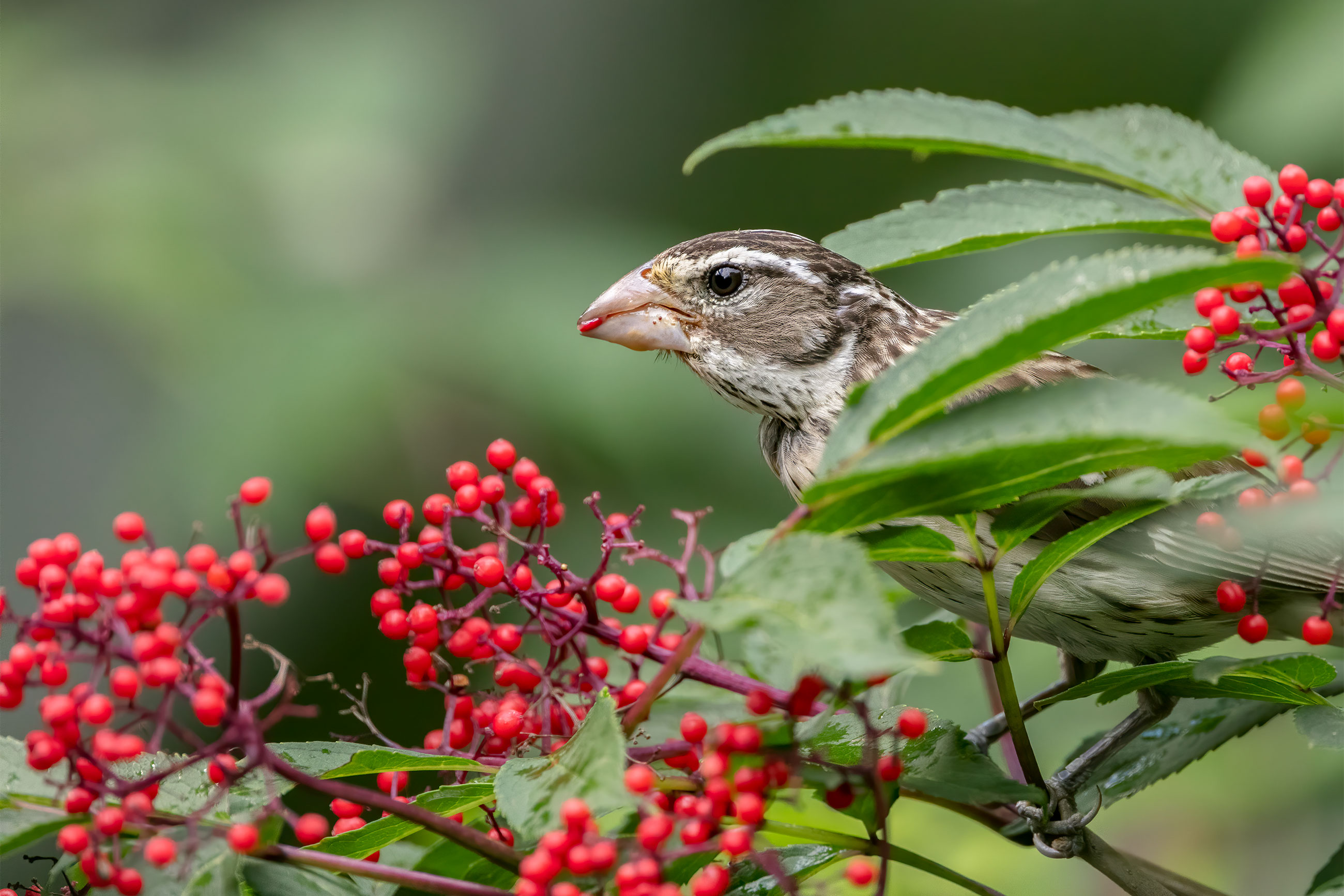
These copse or small shrubs typically grow 5 to 12 feet tall and back up various caterpillars, including that of the largest moth in North America, the cecropia moth. If yous've seen an elderberry supplement at the chemist's, that's because some suggest the night imperial berries may have health benefits for humans, as they're rich in Vitamin C, fiber, and antioxidants, but the research is inconclusive. (Don't consume raw elderberries though, every bit they're toxic to people—but succulent to birds!)
Plant Notes: American Black Elder (S. canadensis) grows in near all of the Lower 48 states.
Bird Notes: Brown Thrashers, Cherry-eyed Vireos, Grey Catbirds, warblers, tanagers, orioles, mockingbirds, and waxwings enjoy elderberries.
Blueberries & Sparkleberries (Vaccinium spp.)

All berries in the genus Vaccinium are edible to humans, and these include familiar fruits like blueberries, cranberries, huckleberries, and lingonberries. Another diversity is sparkleberry (also called farkleberry), which makes bright red leaves in autumn. Blueberries, too, are native to areas of the U.S., and the world's largest producer of wild blueberries is the land of Maine.
Plant Notes: Try sparkleberry (V. arboreum) in the southeastern U.S., from parts of Virginia and southern Illinois to eastern Texas and south-central Florida. Blueberries grow in the eastern U.Due south. and Pacific Northwest.
Bird Notes: Songbirds, including Tufted Titmice, robins, thrashers, and mockingbirds will swallow sparkleberries, and Bobwhite Quail volition browse the berries, as well. Blueberries also attract a diverseness of songbirds, and some might even brand their nest in the bush-league.
Vines & Grass
Honeysuckles (Lonicera spp.)
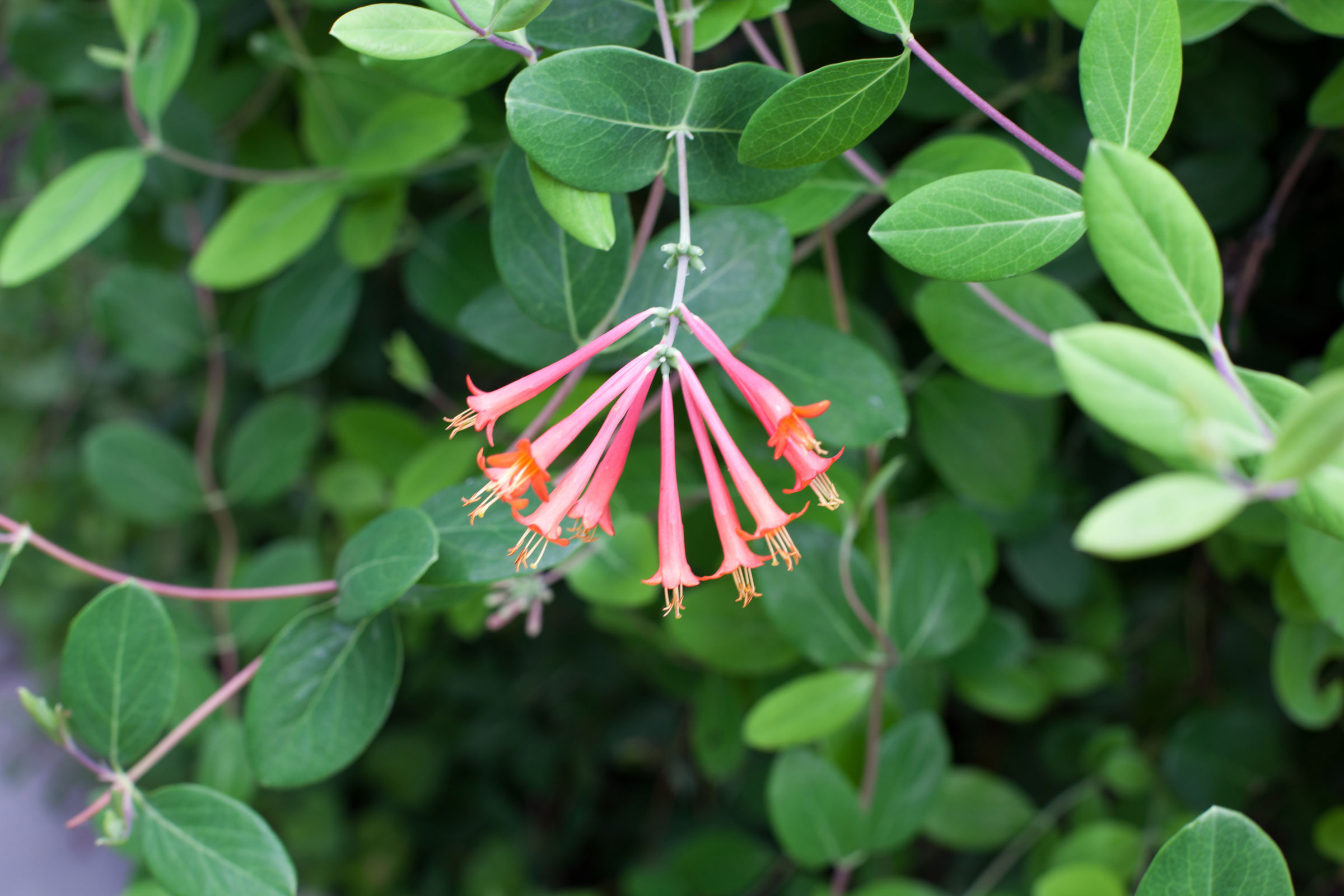
Honeysuckles like well-drained soil and don't require a lot of intendance to grow. Wild honeysuckle may be found climbing copse in forests. These plants add a dash of color to any garden or street with vibrant springtime blossoms and berries in the fall. And of course, you lot can get a sweetness snack past tasting honeysuckle nectar from inside the flowers.
Institute Notes: The non-native species are invasive, soavert:Amur (L. maackii), Tatarian (L. tatarica), Morrow's (L. morrowii), and Japanese honeysuckle (L. japonica). All four can be identified by their hollow stems. Non-native honeysuckle can have negative impacts on birds, from being less nutritious than native varieties, to causing higher mortality rates in nests, likely due to less shelter from leaves, increasing predation. Instead, choose a native species such as trumpet (L. sempervirens) or xanthous honeysuckle (Fifty. flava).
Bird Notes: Hummingbirds are attracted to the blossoms, and Royal Finches and Hermit Thrushes like to consume the berries in fall and wintertime. Baltimore Orioles swallow the flowers during migration.
Switchgrass (Panicum spp.)
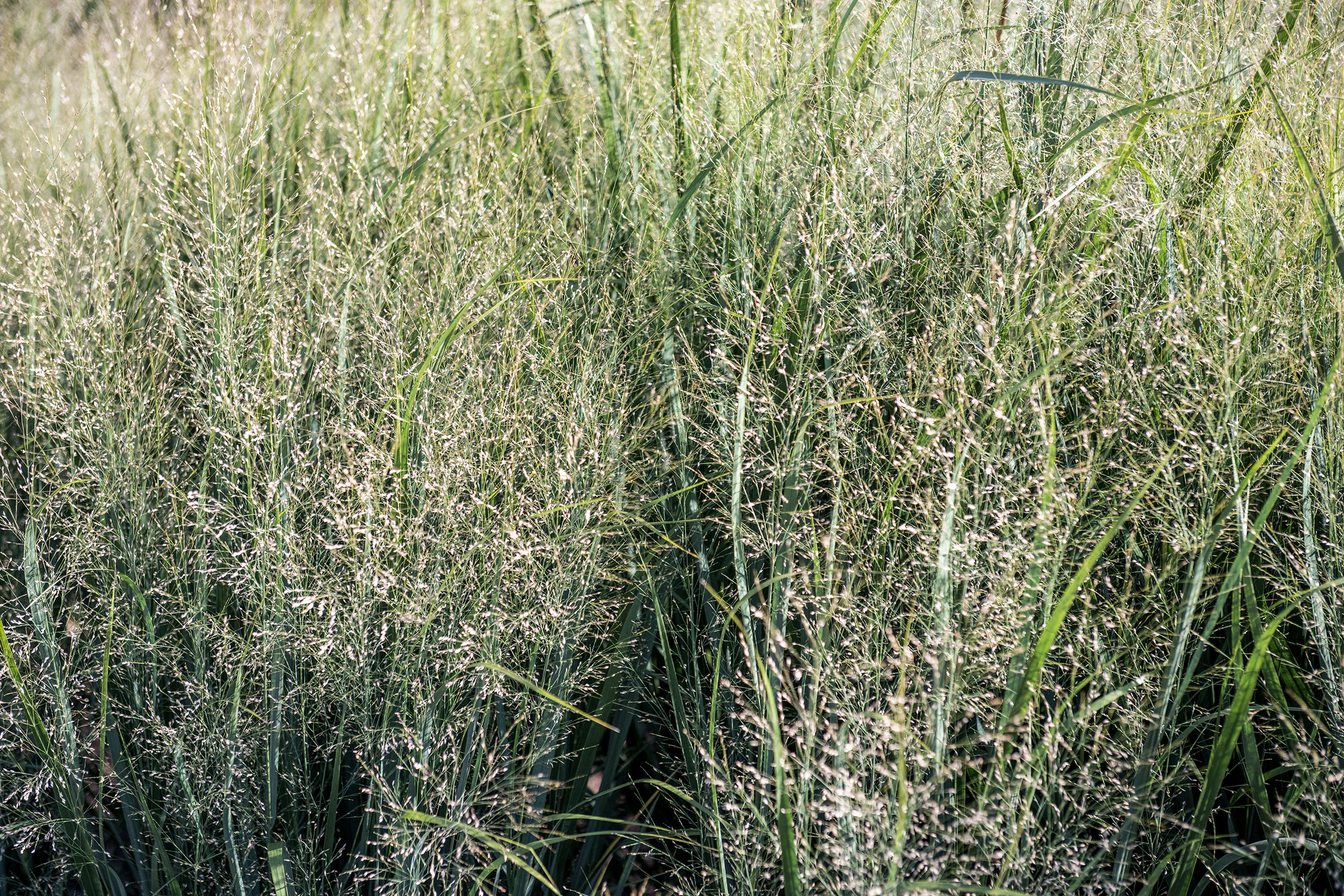
There are more 400 species of switchgrass, but not all are native to the Us. It's a prairie grass whose native range extends beyond the U.Due south. east of the Rockies. With plenty of sunlight, these grasses grow very easily, requiring little maintenance. This 2.5- to 5-human foot-alpine plant blooms in the summertime and seeds in fall and winter.
Found Notes: There are some non-native species in this genus, such as the introduced torpedo grass (P. repens), which is displacing native marshes in Florida. P. virgatum is a common native species. Exist sure to check which varieties are native to your zip code using the Audubon native plants database.
Bird Notes: Songbirds similar to eat the seeds of switchgrass, and the tall vegetation provides shelter for birds.
Muhly grass ( Muhlenbergia spp.)

Muhly grass is hardy—it's drought- and table salt-tolerant—and information technology likes sandy or rocky well-drained soils. In late summer and autumn, some varieties of these plants brandish fluffy plumes of color at the tops of the grasses in pink, royal, or white. Come November, the color fades equally biscuit seeds take its place, creating a buffet for many songbirds.
Plant Notes: This grass is native to the key and eastern U.S., from Kansas to Texas to the Atlantic.
Bird Notes: Muhly grass seeds appeal to sparrows and finches, and some birds may use dead stems of this plant in nesting fabric.
Get to Know You Favorite Snack
Source: https://www.audubon.org/news/get-know-these-20-common-types-native-plants
0 Response to "Get to Know You Favorite Snack"
Post a Comment